Richard Edwards' Ancestors |
Click on a name for info, click on an arrow to follow that branch, click Home to go to the main page, or click for an Alphabetic List of all Names. |
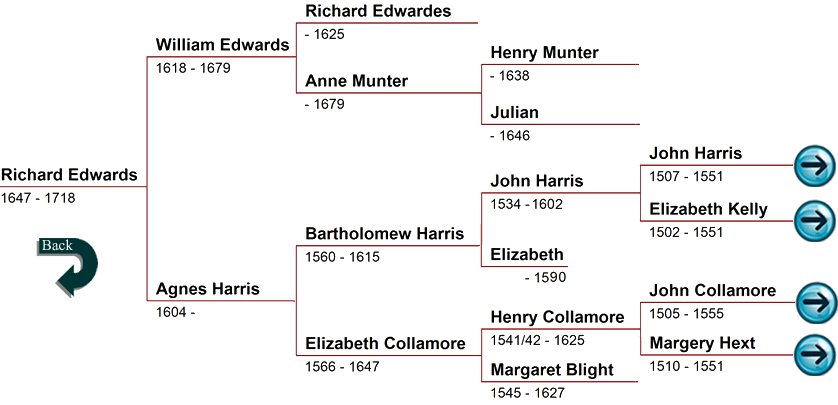
|
| Three lower arrows are disabled at this time. |
| Note: Before 1752 the year began on March 25th. Dates between January 1st and March 24th were at the end of the year, not the beginning. |
William was one of the first settlers of Hartford. Ava Chamberlain in her book The Notorious Elizabeth Tuttle: Marriage, Murder, and Madness in the Family of Jonathan Edwards states “Among early Connecticut pioneers more than half the adult men were single, and most were young and propertyless. Without enough women to go around, finding a mate was often a struggle. Young men, therefore, waited on average until the age of thirty to marry, nine years after reaching the age of legal majority. Despite these obstacles, William Edwards made an unlikely match to a high-status Hartford widow in 1645.” He married widow Agnes Harris Spencer on December 11, 1645, when he was twenty-seven years old and she was forty-one. Agnes' husband, William Spencer, had died five years previous and left her and their three children a respectable inheritance of 231 pounds, which made her a woman of means. William, like his stepfather, was a cooper, his occupation mentioned as such in the records of the Town of Hartford (Hartford Town Votes). Also, like his stepfather, he had problems financially. Although going to court to resolve debt issues was fairly common, he was there far more than the average person. Between June 1644 and September 1670, he was named party in at least sixty-three civil actions and five criminal complaints. His losses in these suits were more than five times as much as his gains, not to mention court costs. He also had difficulties in dealing with his fellow citizens. He was convicted once for slander and once for the more serious charge of “defamation in a high degree.” In two additional suits, charges of “profane swearing, lyeing, drunkenness, wanton loose laciviouse carriages, besides intolerable bawdy language” were not legally proved, but the judges cautioned that they would “seveerly deale” with him if such charges were proved in the future. William was admitted a freeman of Hartford and of the Connecticut Colony on May 20, 1658. In the book A Digest of the Early Connecticut Probate Records: Hartford District, 1635-1700 Volume 1, a record is printed that mentions Edward and his wife which reads as follows: “7 May, 1668: William Edwards, in behalf of his wife, Agnis, Plaintiff; contra Nath: Bearding. Dfnt., in an Action of the Case for lllegall possession of Land belonging to the sd. Edwards, lying on the east side of the Great River, for a Surrender of the sd. Land.” Edwards lost most of the property his wife had brought to their marriage, except the Spencer home lot and two small parcels of land. In 1663, William signed over all property to his wife except for his “workeing tooles.” Agnes took over the running of the household and all financial matters that William proved incompetent to handle himself. William was involved in the witchcraft trial of a middle-aged woman named Elizabeth Seager who was convicted in 1665 and would have been hanged if the governor had not intervened. To support the charge that Seager had made a pact with the devil, one witness repeated a conversation she had overheard between the accused and Edwards. The witness said, that when he told “Goodwife Seager that she did fly” the accused witch replied, “if I did fly William Edwards made me fly.” William was still residing at Hartford on March 4, 1679/80, when he testified regarding his mother's verbal will that left her house to William and his wife Agnes to reside in for the remainder of their lives. There is no record of William Edwards' death. He was most likely interred at Hartford's Ancient Burying Ground, formerly known as the Center Church Cemetery in Hartford, Connecticut, but by 1853 he did not have a discernable gravestone, if he had one to begin with. |
| ~< Back to Chart >~ |
|
Agnes Harris, ninth of eleventh children born to Bartholomew Harris and his wife Elizabeth Collamore, was baptized on April 6, 1604, at Barnstaple, County Devon, England. When and under what circumstances she arrived in New England is unknown. Possibly as early as 1631 Agnes married William Spencer, the eldest child of Gerard Spencer and Alice Whitbread of Bedfordshire, England. Where William and Agnes married is unknown. They resided at Cambridge, Massachusetts during the majority of the 1630s and had three children— Elizabeth, Sarah, and Samuel. William Spencer died in Hartford, between May 4 and May 22, 1640, and left his wife one-third of his estate. As printed in A Digest of the Early Connecticut Probate Records: Hartford District, 1635-1700 Volume 1, he stipulated “that my wife shall have no power to alienatt or make sale of my howse or any prte of my land I leave wthout the consent of two of the prtyes that are to ouersee my Estate.” Five years and seven months later, on December 11, 1645 Agnes married William Edwards, and they had only one child, ancestor Richard. On June 24,1650, the court recorded the following: “With the Information of the Overseers, in presence of Thomas Spencer, the brother of sd. Decd, with the Consent of the wife of William Edwards, this Court do judge that £30 is as much as the Estate here will bear to be sequestered for the Use of the Children, also provided that what shall be paid here or in England of any Estate due to the wife of the sd. William Spencer, 2-3 shall be and remain to the Children.”
Agnes and husband William Edwards were still residing at Hartford on March 4, 1679/80, as per court records, but there is no record of Agnes' death. She was likely interred at Hartford's Ancient Burial Ground, formerly known as the Center Church Cemetery, pictured above. |
| ~< Back to Chart >~ |
Richard Edwardes’ ancestry is unknown. Most researchers believe he was born in Wales and came to London during the reign of Queen Elizabeth I. Other researchers give his birth year between 1579 and 1596, in England or Wales and say his father may have been named Richard or William. With all this uncertainty, we end his line with him. George Frederick Tuttle in his book The Descendants of William and Elizabeth Tuttle refers to him in a footnote as Rev. Richard Edwards, stating “he was a minister of the established chh.” There is, however, no evidence that he ever had a position in a church.
For those educated as a minister, but without a church appointment, teaching was a common occupation. Probably through Ann’s family connections, Richard secured a post as a schoolmaster in the Free-School at Ratcliffe, Middlesex. It was run by the Coopers’ Company of London, of which Ann’s father was a member. His salary was more than 23 pounds a year, possibly supplemented by private pupils. This was a modest income, but adequate for their needs. They lived in relative comfort for the next five years. In 1625 there was an epidemic of bubonic plague in London, which killed 35,000 people. The east end, where they lived, was particularly hard hit. |
| ~<^>~ |
Anne Munter was born between 1583 and 1594 in Maidstone, Kent, England. Her mother’s given name was Julian, but her maiden name is unknown. The name of Julian’s first husband, Anne’s father, is unknown. Anne was raised by her mother and step-father Henry Munter, thus she is known as Anne Munter to researchers. George Frederick Tuttle in his book The Descendants of William and Elizabeth Tuttle refers to her in a footnote stating “ Anne was employed in some capacity in the Queen’s household.” She married Richard Edwards in London England and had had about six children with him. Those known are listed in Donald Lines Jacobus’ book Hale, House, and Related Families as follows – Anne, who was baptized at Henry Munter's house on July 30, 1615 in St. Botolph’s Aldgate; ancestor William; John, who was baptized on October 7, 1621, in Stepney as the “son of Richard of Radcliffe, scholar, and Anne his wife” and died young; Sarah baptized on June 29, 1623, in Stepney and died of plague and was buried in St Dunstan and All Saints Churchyard 22 months later on May 21, 1625.
James Cole was a cooper/carpenter and an educated man as seen in documents he wrote that are in the British Museum in London. They did well until 1634, when James had to flee to from London due to debt which would have landed him in prison. He found employment in Ipswich and tried to make enough to pay off his debts. Before long, James decided that his best bet was to leave England entirely. James and Anne Cole, came to New England, probably in 1639, and settled in Hartford, in the Colony of Connecticut where he was a founder of that settlement as a follower of Thomas Hooker. He had two home lots, one at the south end of colonial Hartford on The Green near the Charter Oak tree, and the other was a smaller lot in the center of Hartford by the first Meeting House (mouse over image left). He also owned an island beside Wethersfield on the south and the Great River on the east and estimated to be about four acres. His name appears on the founders monument (pictured below, he's second from bottom) in the Center Cemetery (Ancient Burying Ground ) behind the First Congregational Church where he is buried. His name is also found on the list of original proprietors who were residents before 1640. In his will he mentions his wife, Ann, several times making his son’s and daughter’s inheritance dependent upon them caring for her. At the end of the will he mentions her again: Anne Munter Edwardes Cole died on February 20, 1679, in Hartford, Connecticut, twenty-seven years after James' death. It is not known where she was buried. A probate record is found in her name printed in the Digest of the Early Connecticut Probate Records: Hartford District Volume 1, 1635-1700 and reads as follows: “Page 33. |
| ~<^>~ |
Bartholomew Harris was born about 1560 probably in Braunton, Devonshire, England. There is no documented proof of his parentage, but it is suspected that Bartholomew is the son of John and Elizabeth Harris. The reason being is that during this period there was a tendency for families to monopolize the office of mayor. Both his supposed father John and his son Richard were mayors of Barnstaple prior to and after the time that Bartholomew was mayor. Another reason is that John named Bartolomew one of the executors of his will dated February 6, 1601, so it is highly suspected that Bartholomew was the third of six children born to John Harris and an unknown wife. Some researchers say Bartholomew’s mother was Ann Beckett, but this is doubtful. Her husband, also named John Harris, was of Landrest in Cornwall and lived from 1525 to 1579. See John’s bio for more on Bartholomew’s mother. On January 18, 1586, he and Elizabeth Collamore were married in Braunton, Devonshire, England, and they had eleven children, four sons and seven daughters (see Elizabeth’s bio for more on this). In The American Genealogist, Volume 63, Donald Lines Jacobus states “Following their marriage, Barthlomew Harris and his wife settled in Barnstaple, co. Devon, where he was a merchant. Prior to 1599, Bartholomew appeared in the parish records without the honorific designation of ‘Mr.’ Starting in 1599, and in all parish records thereafter, the courtesy tiles of ‘Mr.’ and ‘Mrs.’ were applied to him and his wife. In 1597, George Peard was elected Member of Parliament for Barnstaple, Co. Devon, in place of Bartholomew Harris, ‘a choice mislyked by the Earl of Bath,’ who claimed the right to nominate one member.” Joseph Besly Gribble in his 1830 book Memorials of Barnstaple gives a more detailed account of the election and states that “The burgesses, and especially Mr. Harris, seem to have been quite passive in his Lordship’s hands. A seat in the House of Commons was not in those days, quite so valuable as at present.” Bartholomew was elected Mayor of Barnstaple in 1602. Jacobus continues with: “As mayor, his duties were wide, since he was ex officio a justice of the peace and of gaol delivery, clerk of the market, escheator of the town, general warden of orphans, and general overseer of the poor. As chief magistrate, he stood responsible to the Privy Council in London and before the Lord Lieutenant locally. In addition, he had to receive and entertain a steady flow of dignitaries. There were, for instance, twice yearly visits of the justices of assize, the occasional appearance of the Lord Lieutenant, and visits of county magnates as well as commissioners from London, all of whom had to be suitable entertained. Moreover, the mayor was expected to bear the expenses of journeys to London, of messengers to be sent there, of tours of inspection of municipal property, and of clerical assistance. As part of his duties in regulating the economic life of the community, he also supervised various subordinates to handle the day-to-day routine of the markets. Sometime prior to 1610, Bartholomew Harris was named as one of the trustees of the town grammar school in St. Anne's Chapel.” Bartholomew Harris died October 10, 1615, at the age of 55 in Barnstaple, Devonshire, England, a seaport on the west coast of England. He was buried at St Peter's Church there, which is also known as Saint Peter and Saint Mary Magdalene Church (mouse over image left). The inventory of the estate of Bartholomew Harries of Barnstaple, yeoman, was taken on November 22 by his father-in-law Henry Collamore, his brothers-in-law John, Thomas, and William Collamore, and by Matthew Tooker, a fuller of Barnstaple. Administration of his estate was granted to Elizabeth his wife, the next day on November 22, 1615. |
| ~< Back to Chart >~ |
Elizabeth Collamore Harris died 32 years after her husband’s death, and was buried on December 7, 1647, possibly with him, at Saint Peter and Saint Mary Magdalene Church, in Barnstaple, Devonshire, England (this church is sometimes referenced simply as St. Peter's). She left a will dated September 15, 1647, that was proved on January 27, 1648/9, by her unmarried daughter Priscilla. In The American Genealogist, Volume 63, Donald Lines Jacobus states that she “left a bequest to her daughter Agnes Edwards‘ children.” (Mouse over and click on Elizabeth’s will image left to enlarge it in a new window/tab.) |
| ~<^>~ |
Julian, maiden name uncertain, was the mother of ancestor Anne, whom we call Munter. It is believed that Julian’s first husband was the father of Anne and Julian married Henry Munter as her second husband. Many researchers call him the father of Anne, but the way his own will was written, seems to prove he is not, but he probably raised her. Henry Munter is said to have been born some time between 1564 and 1570 in England. He was a member of the Coopers’ Company, which means he was a maker of barrels. He was apparently moderately prosperous as his belongings included a “silver gilt cup and bowl” and a “jewel ringe of gould.” He had at least one daughter, Katherine, named in his will, with his first wife. In his book Hale, House, and Related Families, Donald Lines Jacobus states “The will of Henry Munter, dated 8 Sept. 1638, proved 23 Oct. 1638, gave thirty shillings ‘unto my now wives daughter Anne Cole, the wife of James Cole Cooper,’ and made bequests to Timothy and Abigail Cole, as well as to ‘William Edwards sonne of the said Anne Cole by her former husband Richard Edwards.’” These statements from his will clearly indicate that Julian wasn’t his first wife and him leaving money to Anne and her children, shows some kind of relationship existed between them, but he never called her his daughter. “In the name of God Amen the eight daie of September Anno Domini One thousand six hundred thirtie & eight And in the fourteenth yeare of the reigne of our Soveraigne Lord Charles by the grace of God King of England Scotland France and Ireland defender of the faith &c I Henrie Munter of East Smithfield in the countie of Middelsex [--and] Cooper of London beinge weake in bodie but of sound and perfect memory praise here therefore [goes to] Almighty God consistinge wth myself ye certaintie of deathe & the uncertaintie of the tyme thereof And that I may [----]ence Life I doe make and declare this my Last will and testement in manner and forme following vizt First I [----] my soule into the handes of almightie God my Creator hopeing and assuredlie believinge through the death passion of Jesus Christ his only sonne our alone Saviour to have remission of all my synes and to be made [partaker] of life everlastinge And my bodie I comitt to the earth to bee decentlie buried att the discrecon of my [one] Executrix [hereafter] named And as [concerning] such worldlie goodes & Chattles [which] hath pleased god to [----] mee [withall] I doe will dispose & bequeath ye same in manner and forme following vizt Imprimis I give & bequeath unto my Lovinge daughter Katherine Barrett widowe late wife of George Barrett Cooper [unto] the some of fifteene poundes of lawfull money of England to be paid unto her within six Monthes next after my decease [If] shee shalbe then Livinge But if shee shall happen to decease before the end of the first Six Monthes Then I give and bequeath the said some of fifteene poundes unto Henry Rowland & [Sara] Rowland Children of my said daughter by her former husband Lawrence Rowland deceased equallie to be divided betweene them part and parte [alike] And I doe hereby give unto the said Henry Rowland my seale Ringe of gould whereuppon the Coopers Armes are engraven And alsoe one Silver and guilt spoone and [two] paire of [flaxen] sheetes And I give to the said Sara Rowland my three [----] Ringe of gould And alsoe one Silver and guilte spoone one [----] drawinge [Chest] Landing in my bedchamber & two pair of [flaxen] sheetes Item I give to the said Henry Rowland and Sara Rowland my grandchildren to either of them [twentie] one pounds six Shillinges and eight pence of like money to bee paid unto them when they shall attain to their severall age [& ages] of one and twenty yeares without allowance of any interest for the same Item I give unto the said Henry Rowland one [booke] of Mr Rogers [worke] uppon the [Indyes] one booke of [Josephs] works att [Law--] And one Booke called the Dialogue of [----] Item I give unto the said Rowland one Little Silver guilt Cupp And unto the said Sara I give one Little Silver and guilt [----] to bee delivered unto their mother for their use and use within one Moneth next after my decease and to remain in their [handes] untill they shall accomplishe their said severall age and ages of one and twenty yeares or bee married which shall first happen Item I give and bequeath unto my [now wives] daughter Anne Cole the wife of James Cole [Cooper?] the some of thirtie Shillings sterlinge And to the said James Cole twentie shillinges Sterlinge To bee paid unto them within six monethes next after my decease Item I give bequeath unto Timothie Cole and Abigaill Cole Children of the said Anne Cole ye some of thirty shillings sterlinge apeece to bee paid unto them when they shall attaine to their severall ages of one and twentie yeares Item I give & bequeath unto William Edwards sonne of the said Anne Cole by her former husband Richard Edwards the some of thirty shillinges sterlinge To bee paid unto him within six moneths next after my decease Item I give unto the [three] daughters of Edward Farley my Late deceased brother in law [perf] to [----] Farley fortie shillings to Joane [Farley] twentie shillings & to Marie Farley fortie shillings To bee paid them att their severall ages of one and twentie yeares Item I give unto the poore of the [libtie] of East Smithfield aforesaid twentie shillings to be delivered to the Church warden or Overseere of the poore where most neede shall appear [fit] Item as concerninge all that my [messuage] or Tenemente with the appurtenances thereunto belonginge wherein I now doe dwell and inhabitt [----] & being in East Smithfield aforesaid I give & bequeath the same unto my wellbeloved wife Julain Munter for & during the tearme of her naturall Life And after the said Julians decease I give and bequeath the same [messuage] or Tenement with the appurtenances unto him the before named Henry Rowland & to his heires & assignes forever Upon this condicon that hee the said Henry Rowland within one Moneth next after that hee shalbe [----]fullie possessed of the same Messuage or Tenement shall paie or cause to bee paid unto the said Sara Rowland the some of Tenn pounds of Lawfull english money (if shee the said Sara shalbee then livinge) And if is shall happen the said Henrie Rowland die without yssue of his bodie Lawfullie begotten, Then my Will and meaninge [is] and I doe hereby give and bequeath the said Messuage or tenemt with the appurtenances unto the said Sara Rowland her heires and assignes forever Item the rest & residue of all and singular my goods chattells and p[er]sonall estate whatsoever I doe hereby fullie and whollie give and bequeath unto my said welbeloved wife Julyan Munter whom I doe make full and sole executrix of this my Last will and Testament And I doe hereby alsoe nominate and appoint my Loving friendes William [Henry] & Anthony Kim Citizens and Coopers of London Overseers of this my last Will And I doe give to either of them my said Overseers for their Care and paines thereon to bee taken the sume of Twentie & two sterling apeece to make each of them a Ringe in remembrance of my Love unto them And I doe hereby revoke renounce and Utterly disannul all other former wills & bequests by mee in anywise heretofore made or spoken and this to stand & remain for & as my Last Will and Testamente In Witnes whefreof to [----] Last will and Testamente confirmed & written in [these] three sheetes of paper [annexed] [altogether] I the said Henry Munter have sett my hand and seale the day and yeare first above written Henry Munter: Reade, signed sealed and as the Last will and Testament of the said Henry Munter published and delivered in the [----] of us Christopher Gore and [----] [Colins] [senr]” Julian's maiden name is undocumented, but some say it is Farley because in Henry’s will, he calls “Edward Farley my Late deceased brother in law” and in Julian’s own will she states: “my couzen Marie Warren the wife of Nicholas Warren by the name of Marie Farley spinster” who researchers say is Mary Farley. To this researcher, this isn’t solid proof of her maiden name, but it is a good possibility. It is generally believed that Julian was born in 1572 in the Parish of East Smithfield in Middlesex, England, which is now a part of London. The only relatives she mentions in her will are her daughter Anne, Anne’s children and “my daughter in law Katerine Barret widdowe . . . and to my sister Elizabeth Case . . .” Katerine, as mentioned above, was Henry’s daughter by his first wife. Julian naming her in the will seems to indicate that Julian raised Katherine, or at the very least had a close relationship with her. “In the name of God Amen The [eight] dae of Februarie Anno domini One thousand six hundred Fortie Six And in the [five] and twentieth yeare of the Reigne of [our] Soveraigne Lord Charles by the grace of God King of England Scotland France and Ireland defender of the Faith [&c] I Julian Munter of Eastsmithfield in the Countie of Middmidd[----] beinge sick and weak of body but of good and perfecte minde and memorie thankes be given to God for the same doe make and delare this my last will and testament in manner and form following that is to say [----] First & principally above all earthlie thinge I recommend my Soule unto allmightie God my maker and Creator & to his Sonne Christ Jesus my Saviour and redeemer haveinge through his death [to] be made [partaker] of everlastinge life My body I committ to the earth whereof it was made to be [decentlie] buried att the discretion of my executors and overseers hereafter named And [concerning] the disposeinge of my worldlie estate I give and bequeath the same as followeth vizt Imprimis I give and bequeath unto my grandsonne William Edwards the Sonne of Richard Edwards deceased the summe of thirtie pounds of lawfull money of England Item I give and bequeath unto my granddaughter Abigale Cole the daughter of James Cole the sume of threescore and [tenn] pounds I desire my executors hereafter named to employ to the best benifitt they can for the use of my Said granddaughter untill she shall attaine the age of one and twentie yeares or bee married which shall first happen But if itt shall happen shee shall die or decease before shee shall accomplish the age of one and twentie yeares or be married Then I doe will and my meaninge is That Fortie pounds of the said threescore and Tenn poundes shalbe and remaine for the use of my said grandsonne William Edwards And the other Thirtie pounds ([residue] of the said [Threescore] & Ten pounds) I give and bequeath unto my daughter Ann Cole mother to my said Granddaughter Abigale Cole Item I give unto my said daughter Anne Cole the wife of the said James Cole All my wearringe apaparell Item whereas by my [Former] [will] I have bequeathed unto my cozen Marie Warren the wife of Nicholas Warren by the name of Marie Farley Spinster the sume of Twentie Shillings and five [----] [----] in the consideration of the [poor] and pained shee hath taken of mee in my [----] I [doe] give and bequeath unto her the said Marie Warren the sume of Five pounds more of lawfull money of England Item I give and bequeath unto Mr Samuell Slater Preacher of St Catherines neare the Town of London the sume of twentie shillinges Item I give and bequeath unto the poore of the said St Catherines the sume of [Tenn] Shillinges And unto the poore of Eastshithfield the [----] summe of Tenn Shillings both to be dis[tributed] amongst such poore as my executors and Overseers shall think [best] Item I give unto my daughter in law Katherine Barrett widowe the Summe of Twentie Shillings And to my Sister Elizabeth Case [twentie] Shillinges Item I give and bequeath unto William Lovett of Eastsmithfield [Woodmonger] Joseph Napp of Southmarch in the Countie of Surrey Cooper and Nehemiah Wallington of Eastcheap London [turner] the sume of Twentie Shillinges a piece Item my will and minde is That all and singular the rest and [residue] of my worldlie houshould stuff and estate whatsoever shalbe sould by my said execu[tors] and Overseer for the best benefitt and profitt that maie bee made of the same And the money that shall soe arise and be made thereof (My Funerall charges and Expenses being from there first deducted) I give and bequeath unto my said two Grandchildren before named equallie to be divided between them And I doe hereby will and order That my said Executors shall employ one equall half parte of the money that shalbee made of the land residue of my sd estate To the best profitt they can for the use of my said Granddaughter Abigale Cole until she shall attain the age of one and twentie yeares or bee married as aforesaid which shall first happen And of this my said last will and Testament I doe make & ordaine the said William [Lovett] and Joseph Napp executors And I desire the said Nehemiah Wallington to bee overseer to see this my will performed hereby revoakinge all former Wills And doe establish this to bee my last will and testament In witnes whereof to this my last will and Testament [conteyned] and written in Five Sheetes of paper one annexed to the other I the said Julian Munter have sett my hand and Seale the daie and yeare first above written Julian Munter mark Read signed sealed and as the last will and testament of the said Julian Munter published and delivered in the presence of Henry Rowland Chr Parker Robert Dunn [----]"
|
| ~< Back to Chart >~ |
John served as Mayor of Barnstaple in 1578 and 1596. There is another interesting record in the Barnstaple Parish Register dated September 3, 1590, for the marriage of “Mr. John Harris and Elizabeth Mattacott.” This is just about four months after the first Elizabeth died, so this could be another wife.
In Moger’s Testamentary Causes, there is a 1603 court case listed as “cause of subtraction of legacy between Elizabeth Harris, widow, and Richard Harris, Simon Moungey, Bartholomew Harris and George Stonbare, executors.” This seems to be the second wife, Elizabeth Mattacott Harris, suing John’s children for a share of the estate. Unfortunately, nothing else is known about this. |
| ~<^>~ |
Henry Collamore died and was buried on June 15, 1625. His wife Margaret Blight Collamore died the next year and was buried on November 27, 1626. Both were buried in the St. John the Baptist Churchyard (mouse over picture right) in Bishop's Tawton, in Devonshire. |
| ~< Back to Chart >~ |
John Harris was born about 1507 in Stowford, Devonshire, England, to William Harris and Thomasine Hayne. His only known sibling was a sister named Wilmot. He was known as the Esquire of Stone, a title handed down to him by his grandmother, the heiress of Stone. He was an English barrister of the highest rank, a British lawyer who spoke in the higher courts of law. As a lawyer of high reputation, he was chosen in 1535, Autumnal Reader of Lincoln's Inn. In 1540 he was called to the degree of Serjeant-at-Law to King Edward VI and recorder of the city of Exeter. Prince writes in his book Worthies of Devon about John "The emenency, of this great lawyer in his profession, we may infer from that considerable estate he acquired, and left to his family. For to his own fair inheritance he added, the hundred, manor, and advowson of Lifton, near adjoining to Hayne, which he purchased from Lord Nevil, Earl of Westmoreland." During this time Serjeant John Harris married Elizabeth Kelly in Devonshire and they had at least eight children (see her bio for more on the marriage and children).
“In the name of the father and of the sone and of the holy goste three p'sones and one god in Trinitie. I John Harrys one of the kings menesters Seargeant at Lawe knowlyging my selfe to be a man mortall, and not to lyve in this myserable world forever, but when wher or howe I shall change this lyfe yt ys only in the knowlege of Almightie god my maker and redemer, therefore I being now of p'fytt mynd and good remembrance Laudes and thanks be to J'su Christ our lorde. Neverthelesse avowing of the casuallytie of this unsure and frayle worlde The xxth daye of Aprill in the yere of our lorde god a Thousande fyve hundreth and fyftie. And in the soverign yere of the Reigne of o'r soverigne lorde Edward the Sixte by the grace of god of England ffraunce and Ireland kinge defend'r of the faithe and of the churche of England and also Irelande the supreme head make and declare my Last will and testament as well of all my Maners Landes tents and her'ditaments with app'tences what soever they be wherof I may laufully by the lawes of the Realm declare my will and Testament. As of all my goodes and cattalls in maner and forme folowing That is to saye ffirst I will and bequeathe my soule into t'handes and keping of Almyhtie god. In manus tues domine comendo spiritus meum, umbley beseching the good lorde my maker & redemer of his mercy and grace and for the bytter passion that J'su Christ o'r lorde suffered for the redemption of us myserable synners that my soule after this transitorie lyfe and sepa'con from the bodye may be with christe o'r lorde and to have the lyf everlasting Amen. And I do most humbley beseche our lorde Jesu Christ that I may wth a penytent hert saye at the tyme of my death these wordes In Manus tuas dme. comendo spir. Meum. And I will my bodie to be buried within the pishe church of Stofford or Lyfton in Devonshire or ells where yt shalbe thought most convenient by my Executores and in suche maner as by my Executors shalbe thought mete and convenient according to my degree. And I will that ther shalbe bestowed and distributed unto er'vy prest that shalbe at my buryall doing their obsequyes viii d. And I will that my Executors shall distribute and delyver unto ev'ry poore housholder not being worthe in goods and cattells of the value of xl sh. inhabiting within the pishes of lyfton, Stowford, Kelly maristowe, Lew, Trencherd broodwoodwiger and Thrusshelton to ev'ry suche housholder xx d. And I will that there sahll be distributed at my buryall and months mynde in Almes suche somms of money or do suche other things as shalbe mete and convenyent for the same accordingly as shalbe thought mete by my executors and overseers. And I will that my Executors assone as they may after my decease shall consent and paie my debts yf any be and after my legacies according as I shall hereafter expresse and declare. Item: I will unto the p'son of Stoford for tithes and obl'acions forgotten tenne shillings. Item: I will and bequeathe unto my daughter Wylmot towarde the performent of her marrage the somme of two hundreth marks. the somme to be delyvered unto her at the Daye of her mariage or shortly after so that she shalbe ordered and maried by the good will & assent of her mother and by th'assent of my sonne in Lawe John Wyse Esquire my sonne Will'm Harrys & John Crebyngton gentilman and other of her frends yf the said Wilmot be not otherwise preferred in my lyfe. Item: I will and bequeathe unto my sonnes Henry Harrys, John Harrys, Olyver Harris, Anthony Harris and Arthur Harrys to every of them sevrally the somme of fourtie poundes or the value therof the same to be delyvered to every of them pticularly as they shall accomplishe and come to their sev'rall ages of xxiiii yeres yf they shalbe then in lyf, and of good rule and wilbe ordered by my Executors and the p'sons before named yf they be not otherwise by me in my lyfe tyme. And yf eny of them dye before he or they accomplish the said age of xxiiii yeres or refuse to be orderyd by my Executors or be not of good Rule & governance Then I will his or their pte That shall decease before the said Age or refuse to be ordered as beforeys saide or shalbe by me preferred shall goo and be to my Executors towards the p'formance of this my will. Item: I will that myn Executors in the meanetyme before my said sonnes shall come unto their said ages of xxiiii yeres shall applye and converte the said severall sommes of money to the sev'rall p'fitt comoditie and advantage of my said sonnes. Item: I will and bequeath unto my daughter Alice Wyse the some of xxx L and unto her sonne Thomas Wyse my god sonne and John Wyse her second sonne to ev'ry of them the some of fyve marks and unto her two daughters Elizabeth Wyse and Alice Wyse to every of them the some of xl sh. Item: I will to every of my god children xij d. Item: I will unto my servantes called my wayting servantes the some of fyve marks in rewarde equally to be devided amongst them. Item: I will & bequeathe unto my masters the Judgs and servants of the house of ffletestreete and unto my Msr. and late fellows of the house of lyncolnshire wherin I was sometyme a fellow ther to eny of the said houses the some of xx sh. desiring them to praye for my soule and all xxen soules. Item: I will that Elizabeth my wief shall have the custodye keping and occupation of all my plate Cattalls and all other my stuff of housholde that I have at hayne in this my pnt. testament not otherwise bequeathed during her lyfe yf she lyve soole and remayne a wydow & dwell at Hayne. And after her death or yf she mary and remayne not a wydow and dwell not at hayne but willingly absent herself of her dwelling ther by the space of one hole yere wt'out a reasonable cause. Then I will that William Harrys or suche p'sonne as shalbe my next heyre and have my mansyon house at Hayne, shall have the custodye keping and occupation of all my said plate cattall and stuf of houshold at hayne aforesaid. And my very will and intent ys that the same p'son shall have but the use and occupation of all the said plate cattell and stuf of houshold during his or her lyfe and to change the cattell and other stuf of houshold when mete shalbe, and to leave all after his or her decease to suche p'son as shalbe my next heyer and so to be lefte there from one to another. Item: I bequeath unto my Sister Wylmott xl sh./ & unto her sone Richard ffoster the some of xl sh. Item: I will that Elizabeth my wief and the said John Wyse my sonne in Lawe John Cerbyngton and John Obeley sahll have all my bonds tents and others hereditaments and Tyverton in the Countie of Devonshire & in Wythypehe in the Countie of Som'r't. And also all my Manors of St. Nyott & boserwell and th'app'tences in the Countie of Cornwall And all my mesuage Lands tenements & hereditaments with th'appurtences in Saynt Nyott Bossernell Lustuthyell Saynte Neighton in the Countie of Cornwall whiche I late purchased of my Awnte Margery Terrell Widow. And also all my Lands and tents with th'appurtences in Trethnest in the said Countie of Cornwall during the terme of tenne yeres. And wth the issues and profytts comying and rysing of the same shall content & paye first my debts and then my legacies, yf my goodes and cattells which I shall have & wherof I have nor shall make my legacies be not sufficent to satisfie the same debts and legacies. And I will the same John Wyse, John Cernyngton and John Ebelelgh shall have toward their paynes takyn in seying this my will p'formed to every of them the some of fyve marks over & above all suche rest and chargs that every of them shall sustayne in and about the same. And yf any surplysage of th'issues and profytts remayne over and above my said debts & legacies I will yt shall remayne to my next heyre. Also I will my wief Elizabeth shall have all my mansion house at Hayne and all my mesuages lands tents and other hereditaments wth'appurtenances in hayne Newton and Stowford and also all my mans of Cheryton ffitzpayn, Domscombe and Tobhamwyke with'appurtanences and all my lands and tents with'appurtenences in Cheryton ffitzpayne, Dumscombe Tobhamwyke and Bryddestow in the Countie of Devonshere during her lief yf she lyve a wydow and unmaried. And yf she mary, Then I will her estate of and in the said mans Landes and tents to her willed by this will to be voyde and cesse. And then I will she shall have yerely during her lyf but only an Annuitie or yerely rent of Lj L, xiii sh., iiii d. going into yerely of the said mans and other the premisses to be payd yerely at two sev'rall termes of the yere that ys to saye at the feast of Ester and Saynt Michell th'archangell by even porcions [illegable] aclase of distres for the none payment therof. Item: I will that my said wief shall yerely during the terme of fyve yeres distribute the some of foure pounds toward the giving and fynding of foure poore scollers in the universitie of Oxford suche as she shall think mete and appte to learne and be studens there. Also I will that after the death of the said Elizabeth my wief all the said mans Landes tents and other the premisses willed unto the said Elizabeth shall remayne and in unto t'heyres of my body lawfully begotten. And for default of suche yssue the remaynder therof unto my right heires fore'er. Item: the residue of all my goodes and Cattalls not before bequeathed I give unto Elizabeth my wief and to William Harrys my sonne whome I constitute ordegne and make my only Executors to se'this my will p'formed. Thes beinge witnesses John Obelegh, John Harrys the younger, Richard Calmady, Thomas Collyn, Vyncent Calmady & other.” |
| ~< Back to Chart >~ |
Elizabeth Kelly's birth has been estimated to be about 1502 in Ratcliffe, Devonshire, England, to Michael Kelly, Esquire of Ratcliffe and wife Alice Kelly (maiden name). Elizabeth was the youngest of their three known children. In the Devon Archive Catalogue, there are two records which help date her marriage to John Harris in Devonshire. The first is a Bond dated 1524, where “Alice Coryton [her mother] widow of Richard Coryton esq., and William Kelly son and heir of Michael Kelly esq, . . . to allow John Harris, gent., and Elizabeth, his wife to enjoy messuage lands and tenements in Germansweek formerly held by Michael Kelly, esq., and the moiety of lands and tenements in Holsworthy called the Wodeparke and Kemenparke, which were conveyed to” them. The second is a Marriage Settlement dated 1525, where her brother, “William Kelly son and heir of Michael Kelly esq.,” is giving “ John Harris son and heir apparent of William Harris, gent., and Elizabeth Kelly, daughter of Michael Kelly and sister of William, . . . all the messuages and lands in Germansweek inherited by William from Michael Kelly his father.” So they were married in or shortly before 1524, and they had at least eight children together — William the eldest and heir, born about 1524/25; Henry born about 1526; ancestor John; Oliver; Anthony; Alice born about 1543; Arthur; and daughter Wilmot, who was unmarried at the time her father’s will was written .One of the more interesting of her children was her son Oliver. He was the captain of the ship Mary Holloway, which engaged in Privateering. With the support of Queen Elizabeth I, “privateers acted in service to their country, and many of them gained both wealth and social standing.” In the early 1560’s the Holloway attacked a French ship in a Spanish port, and Harris was captured and held in prison at Sans Sebastian. On June 17, 1564, there is an account of Oliver’s letter to the English ambassador to Spain asking, “to procure their deliverance from prison, where they have remained almost eight months in such penury that half of their men have died for lack of food, and the rest live by alms of the country, where they are utterly abhorred and ordered like Turks.” Sometime after 1565, when peace between Spain and England had been agreed, the Holloway crew was released, but it is not certain that Oliver survived until then. For the complete story on this, read R.W. Harris’ online account, Oliver Harris the privateer and his ordeal in Spain. In The UK National Archives, there is a record dated 1532 to 1538, where John Harris and Elizabeth, his wife went to court against Elizabeth’s brother William Kelly, esquire, and her remarried mother Alice Coryton. The papers read: “Detention of deeds relating to a messuage and land in Germansweek, and instigating excessive claims to service by the bailiffs of the prior of Frithelstock.” It is not known when or where Elizabeth Kelly Harris died, but she outlived her husband and probably died in Devonshire, England. |
| ~<^>~ |
John Collamore was born about 1505, to parents Peter Collamore and Isabel Cushe in Luscott, in the parish of Luscott, in the Braunton Hundred, in Devonshire, England. In the combined Visitations of Devon 1531, 1564, and 1620, it states John is of Luscott in the parish of Braunton, but in the 1620 one it simply states of Braunton. In Sir William Pole’s, Collections Towards a Description of the County of Devon, it states Luscot is a parish in the Braunton Hundred. Today the only references to Luscot are about 2 miles east of the town of Braunton— a forest called the Luscott Plantation; a hamlet called Luscott Barton; and an area called Luscott Warren. John married Margery Hext about 1531 in the small town of Pickwell within the Georgeham Parish in Devonshire and they had seven sons and four daughters. In the UK National Archives' catalogue, there is a Chancery Court Record dated 1553-1555, for a John Colomore that may be our John. The subject of the case is listed as Tenement in Braunton of the demise of Patrick Bedlowe. Devon. It seems brothers Thomas and Richard Incledon were suing John Colomore, Katherine Incledon and others over this matter. None of these surnames are familiar, but it is odd that it ends the year our John died. There is just not information to know for certain that this is about our John. John died four years after his wife and was buried in the St Brannock Churchyard in Braunton on April 17, 1555 (mouse over photo right for more info). ~<^>~ Margery Hext was born about 1510, probably in Pickwell, in the Georgeham Parish in Devonshire, England, to parents Thomas Hext and Wilmot Poyntz. She married John Collamore about 1531 and had at least eleven children all baptized and/or married at St Brannock’s In the book Ancestral Roots Of Certain American Colonists Who Came To America Before 1700, the authors note that in John Lambrick Vivian’s book The Visitations of the County of Devon, Margery is placed in the wrong generation. Vivian places her as the granddaughter of Thomas Hexte, her parents being George Hext of Pickwell (Margery’s brother) and Mary Parker. Ancestral Roots says “p. 484 for Hext (Vivian errors in Hext pedigree placing Margery Hext in wrong generation).” Ancestral Roots gives no explanation as to why it’s in error, but ages and dates seem to support this, although there is no documentation of ages or dates. Being that the original The Visitation of the County of Devon in the Year 1620, states under the Collamore family that John married the “d. of Hext of Pickwell in St. George Hame,” her name and father are both uncertain. Every book and researcher has Margery as the daughter of Thomas, so there must be other evidence to support this. To this researcher is seems very possible that they were simply placed incorrectly in Vivian’s visitation. Margery Hext Collamore died and was buried in the St Brannock Churchyard in Braunton, on August 22, 1551. |
| ~< Back to Chart >~ |
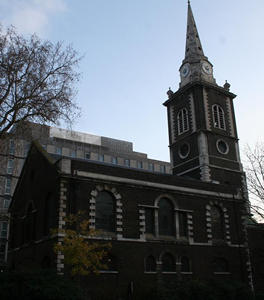 William Edwards was purportedly baptized at the parish of St. Botolph's without Aldgate (pictured right), in east London, England on November 1, 1618. He was the son of Richard & Ann Munter Edwards. His father died and his mother married James Cole. He immigrated to America in 1635 to Hartford from England with his mother & step dad.
William Edwards was purportedly baptized at the parish of St. Botolph's without Aldgate (pictured right), in east London, England on November 1, 1618. He was the son of Richard & Ann Munter Edwards. His father died and his mother married James Cole. He immigrated to America in 1635 to Hartford from England with his mother & step dad. 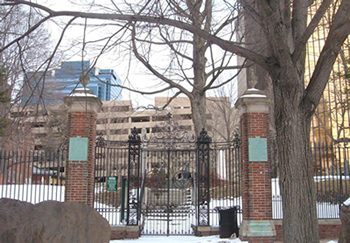 Agnes is claimed to be the maternal descendant of Clovis the Riparian, Frankish King of Cologne, who was living in 420 A.D. This descendant finds the claim that Agnes was the descendant of someone who lived almost 1,200 years beforehand, with all of the intervening connections required, dubious. What can be said with certainty is that Agnes, by her first husband, was the ancestress of Rev. Lyman Beecher, father of Harriet Beecher Stowe, author of "Uncle Tom's Cabin." By her second husband, Agnes was the great grandmother of Rev. Jonathan Edwards, one of the most famous of 18th century New England divines, latter the grandfather of Aaron Burr, Vice President of the United States to Thomas Jefferson. Unfortunately, Burr was also the antagonist, and infamous winner, of the 1804 Alexander Hamilton-Aaron Burr pistol duel. After the duel, which resulted in Hamilton's death, Aaron Burr's life changed dramatically, and not for the better.
Agnes is claimed to be the maternal descendant of Clovis the Riparian, Frankish King of Cologne, who was living in 420 A.D. This descendant finds the claim that Agnes was the descendant of someone who lived almost 1,200 years beforehand, with all of the intervening connections required, dubious. What can be said with certainty is that Agnes, by her first husband, was the ancestress of Rev. Lyman Beecher, father of Harriet Beecher Stowe, author of "Uncle Tom's Cabin." By her second husband, Agnes was the great grandmother of Rev. Jonathan Edwards, one of the most famous of 18th century New England divines, latter the grandfather of Aaron Burr, Vice President of the United States to Thomas Jefferson. Unfortunately, Burr was also the antagonist, and infamous winner, of the 1804 Alexander Hamilton-Aaron Burr pistol duel. After the duel, which resulted in Hamilton's death, Aaron Burr's life changed dramatically, and not for the better.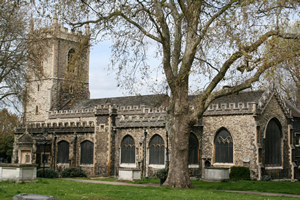 Richard married Ann Munter in London, England. According to Ava Chamberlain, in her book about Elizabeth Tuttle, it was likely in 1614 “for their first child was baptized in July of the following year.” Their second child was ancestor William. Chamberlain seems to say that they had about six children (see Anne’s bio for details on the known children).
Richard married Ann Munter in London, England. According to Ava Chamberlain, in her book about Elizabeth Tuttle, it was likely in 1614 “for their first child was baptized in July of the following year.” Their second child was ancestor William. Chamberlain seems to say that they had about six children (see Anne’s bio for details on the known children).  Richard died in August of that year and, apparently so did all of their children except William. Richard was buried on August 31, 1625 in the St Dunstan and All Saints Churchyard. This church has a long tradition of nonconformity where, according to Ava Chamberlain, “religious radicalism dated back to the reign of Henry VIII, when its rector was burned for heresy.” The church's burial record (mouse over image for more) seems to read under 1625, August 31 “Plague Richard Edwards Schoolmaster of Ratcliffe . . .[illegible] . . . Day.”
Richard died in August of that year and, apparently so did all of their children except William. Richard was buried on August 31, 1625 in the St Dunstan and All Saints Churchyard. This church has a long tradition of nonconformity where, according to Ava Chamberlain, “religious radicalism dated back to the reign of Henry VIII, when its rector was burned for heresy.” The church's burial record (mouse over image for more) seems to read under 1625, August 31 “Plague Richard Edwards Schoolmaster of Ratcliffe . . .[illegible] . . . Day.” After her husband died, she married twice widower James Cole on December 6, 1625 in Whitechapel in the parish of St Dunstan and All Saints, (pictured above) in the Borough of Tower Hamlets, Stepney, Middlesex, England. (Mouse over image right.) He accepted Anne's sole surviving son as his own. They had at least four children together, all baptized at St. Mary’s, Whitechapel, Stepney, London on the dates given – James on October 29, 1626, who died before age 5; Abigail on April 6, 1629, their only child who lived to adulthood; another James on December 27, 1631 who died young; and Timothy on November 17, 1633, who died before the age of 4.
After her husband died, she married twice widower James Cole on December 6, 1625 in Whitechapel in the parish of St Dunstan and All Saints, (pictured above) in the Borough of Tower Hamlets, Stepney, Middlesex, England. (Mouse over image right.) He accepted Anne's sole surviving son as his own. They had at least four children together, all baptized at St. Mary’s, Whitechapel, Stepney, London on the dates given – James on October 29, 1626, who died before age 5; Abigail on April 6, 1629, their only child who lived to adulthood; another James on December 27, 1631 who died young; and Timothy on November 17, 1633, who died before the age of 4.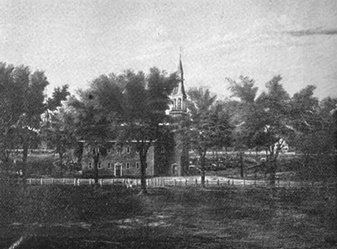 He learned of the need for skilled craftsman like himself in a new colony being formed in Hartford, Connecticut. Coopers were in demand as there was a growing maritime business in which barrels were the primary shipping containers. Anne’s step-father died in October of 1638 and the modest inheritance she and her children received from him undoubtedly assisted them in paying for passage to the colony.
He learned of the need for skilled craftsman like himself in a new colony being formed in Hartford, Connecticut. Coopers were in demand as there was a growing maritime business in which barrels were the primary shipping containers. Anne’s step-father died in October of 1638 and the modest inheritance she and her children received from him undoubtedly assisted them in paying for passage to the colony.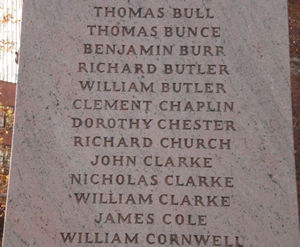 “I give unto my deare and well beloved wife Ann Coale all my houshold stuff of every kinde undisposed of, with all my Cattle and Crop of Corne now on the ground, with all my debts owinge to mee, provided that shee payes all my just debts and defray all that charge wch shall be thought necessary by the ourseers of this my will for my Christian Burial. . . And further, I doe appoint my deare and well beloved wife Ann Coale to be my whole Executrixe of this my last will and testament.”
“I give unto my deare and well beloved wife Ann Coale all my houshold stuff of every kinde undisposed of, with all my Cattle and Crop of Corne now on the ground, with all my debts owinge to mee, provided that shee payes all my just debts and defray all that charge wch shall be thought necessary by the ourseers of this my will for my Christian Burial. . . And further, I doe appoint my deare and well beloved wife Ann Coale to be my whole Executrixe of this my last will and testament.” Gribble goes on to tells us that on June 6, 1605, the Earl of Bath was involved in an indictment against Bartholomew (because he was Mayor when the building was begun) and two other men about a building that was deemed as an annoyance to Boats. So it seems the Earl really didn’t like Bartholomew!
Gribble goes on to tells us that on June 6, 1605, the Earl of Bath was involved in an indictment against Bartholomew (because he was Mayor when the building was begun) and two other men about a building that was deemed as an annoyance to Boats. So it seems the Earl really didn’t like Bartholomew! Elizabeth Collamore was baptized on September 2, 1566 in Bishop's Tawton, county Devon, England. She was the eldest daughter of at least nine children born to parents Margaret Blight and Henry Collamore. Elizabeth married Bartholomew Harris on January 18, 1586, in Braunton, which is about eight miles northwest of Bishop's Tawton. They had eleven children all baptized on the dates shown at St. Peter and Saint Mary Magdalene’s Church in Barnstaple (mouse over picture right), Devonshire, England – George on March 15, 1588/89; Agnes on January 2, 1590/91, who died in 1593; Prisilla on December 9, 1592; Johane (Joan) on March 29, 1595; John on November 12, 1597; Phillipp on December 1, 1599, who died at two months old; Phillippa on December 15, 1600; Elyzabeth on November 28, 1602; ancestor Agnes on April 6, 1604; Richard on April 30, 1608; and Marye on January 20, 1609/10. Barnstaple is about five and a half miles southeast of Braunton.
Elizabeth Collamore was baptized on September 2, 1566 in Bishop's Tawton, county Devon, England. She was the eldest daughter of at least nine children born to parents Margaret Blight and Henry Collamore. Elizabeth married Bartholomew Harris on January 18, 1586, in Braunton, which is about eight miles northwest of Bishop's Tawton. They had eleven children all baptized on the dates shown at St. Peter and Saint Mary Magdalene’s Church in Barnstaple (mouse over picture right), Devonshire, England – George on March 15, 1588/89; Agnes on January 2, 1590/91, who died in 1593; Prisilla on December 9, 1592; Johane (Joan) on March 29, 1595; John on November 12, 1597; Phillipp on December 1, 1599, who died at two months old; Phillippa on December 15, 1600; Elyzabeth on November 28, 1602; ancestor Agnes on April 6, 1604; Richard on April 30, 1608; and Marye on January 20, 1609/10. Barnstaple is about five and a half miles southeast of Braunton.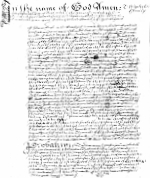
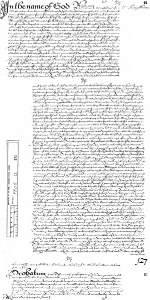
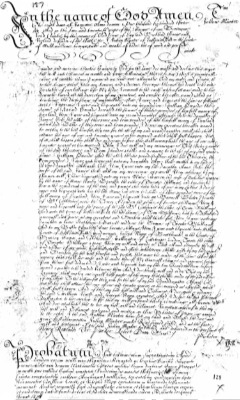

 Henry Munter died in East Smithfield, London, England and was buried on October 19, 1638 at Guildhall, St Botolph Aldgate Church in London. His burial record (mouse over image on left) reads "Henry Munter ...[citizen] and …[resident] of London." Julian died most likely in London and was buried in the same cemetery as her husband on January 20, 1646. Her record (mouse over image above right) reads "Julian Munter …. James Cole." The handwriting on both records is difficult to read. At the time of her death, her daughter Ann was married to James Cole, so it could say something that means mother-in-law to or that James Cole paid for the burial.
Henry Munter died in East Smithfield, London, England and was buried on October 19, 1638 at Guildhall, St Botolph Aldgate Church in London. His burial record (mouse over image on left) reads "Henry Munter ...[citizen] and …[resident] of London." Julian died most likely in London and was buried in the same cemetery as her husband on January 20, 1646. Her record (mouse over image above right) reads "Julian Munter …. James Cole." The handwriting on both records is difficult to read. At the time of her death, her daughter Ann was married to James Cole, so it could say something that means mother-in-law to or that James Cole paid for the burial.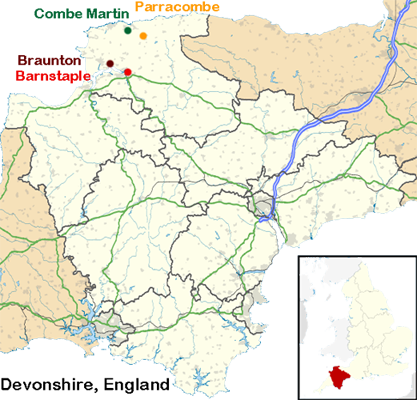 John Harris was born in North Devonshire, England, probably in 1534 in Brauton, which is about 5 miles from Barnstaple. He was the third son of eight children born to parents John Harris and Elizabeth Kelly. He not only is mentioned in his father’s will written in 1550, but he witnessed it also as John Harrys the younger. He married and had at least six children all baptized in Braunton on the dates shown – John on August 12, 1554; daughter Willmott on February 18, 1555; ancestor Bartholomew; Richard about 1562; Anne on January 4, 1563/64; and Willm (William) on January 28, 1567/68, and died at four years old on October 7, 1572. Some researchers say his wife was Ann Bennett of Cornwall, but this is incorrect. She was married to John Harris of Lanrest who died in 1579. Our John lived and died in Barnstaple. There is a burial record dated May 7, 1590, in the St. Peter’s Barnstaple Parish Register for a “Mrs. Elizabeth, wife of Mr. John Harris” who very well may be his wife. Not only is he listed as Mr. John Harris on his own burial record, but his son Bartholomew and wife are listed in that manner also. Being that the Mr. and Mrs. designation was only used for ranking officials and their wives, this is strong evidence that Elizabeth was his wife. Whether she is the mother of all of his children is still not proven, but it seems very likely she is.
John Harris was born in North Devonshire, England, probably in 1534 in Brauton, which is about 5 miles from Barnstaple. He was the third son of eight children born to parents John Harris and Elizabeth Kelly. He not only is mentioned in his father’s will written in 1550, but he witnessed it also as John Harrys the younger. He married and had at least six children all baptized in Braunton on the dates shown – John on August 12, 1554; daughter Willmott on February 18, 1555; ancestor Bartholomew; Richard about 1562; Anne on January 4, 1563/64; and Willm (William) on January 28, 1567/68, and died at four years old on October 7, 1572. Some researchers say his wife was Ann Bennett of Cornwall, but this is incorrect. She was married to John Harris of Lanrest who died in 1579. Our John lived and died in Barnstaple. There is a burial record dated May 7, 1590, in the St. Peter’s Barnstaple Parish Register for a “Mrs. Elizabeth, wife of Mr. John Harris” who very well may be his wife. Not only is he listed as Mr. John Harris on his own burial record, but his son Bartholomew and wife are listed in that manner also. Being that the Mr. and Mrs. designation was only used for ranking officials and their wives, this is strong evidence that Elizabeth was his wife. Whether she is the mother of all of his children is still not proven, but it seems very likely she is.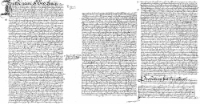
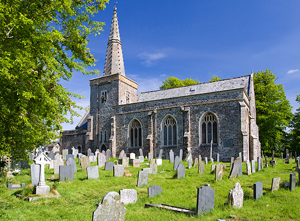 Henry Collamore was baptized on January 12, 1542, in Braunton, Devon, England. He was sixth of eleven children born to Margery Hext and John Collamore. His wife, Margaret Blight, was born about 1545 in Bishop's Tawton, Devon, England to . . . Blight of Tawton. They married before September 5, 1563, and had at least nine children together, all baptized in Bishops Tawton on the dates shown – John, the eldest son and heir; ancestor Elizabeth; Thomas; Agnes on April 24, 1574; Katherine on May 12, 1576; Margaret on August 9, 1578; Susanna on February 15, 1580; William on June 16, 1588; and Rebecca.
Henry Collamore was baptized on January 12, 1542, in Braunton, Devon, England. He was sixth of eleven children born to Margery Hext and John Collamore. His wife, Margaret Blight, was born about 1545 in Bishop's Tawton, Devon, England to . . . Blight of Tawton. They married before September 5, 1563, and had at least nine children together, all baptized in Bishops Tawton on the dates shown – John, the eldest son and heir; ancestor Elizabeth; Thomas; Agnes on April 24, 1574; Katherine on May 12, 1576; Margaret on August 9, 1578; Susanna on February 15, 1580; William on June 16, 1588; and Rebecca. 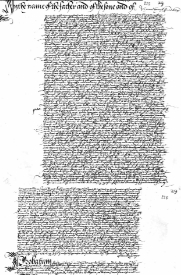
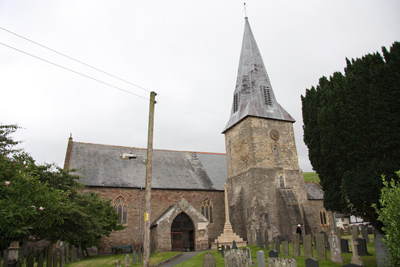 It may be that Luscot was a manor that existed in the sixteenth century, but is now gone.
It may be that Luscot was a manor that existed in the sixteenth century, but is now gone.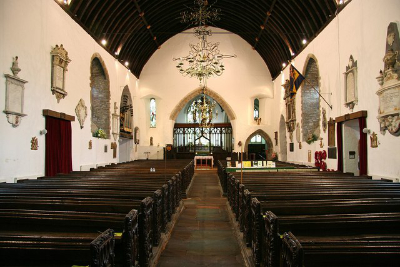 Church in Braunton on the dates shown – Wilmot born about 1532, married Phillip Sweete on January 16, 1553/4; John about 1537, married Elizabeth Bright on June 6, 1555; Richard on March 4, 1538/39 who died the next month on April 9th; twin daughters Petronell and Margaret on February 24, 1539/40, Petronell married William Perrin on September 23, 1563, and Margaret married William Royger on July 2, 1559; ancestor Henry; Alice about 1544, married Richard Symons on July 28, 1567; William about 1545; Peterabout 1547, is believed to have married a woman named Edith; Hugh on March 2, 1548/49 but died three months later on June 4; and Robert on September 29, 1550. (Mouse over the photo of the interior of St Brannock's church on left for more info.)
Church in Braunton on the dates shown – Wilmot born about 1532, married Phillip Sweete on January 16, 1553/4; John about 1537, married Elizabeth Bright on June 6, 1555; Richard on March 4, 1538/39 who died the next month on April 9th; twin daughters Petronell and Margaret on February 24, 1539/40, Petronell married William Perrin on September 23, 1563, and Margaret married William Royger on July 2, 1559; ancestor Henry; Alice about 1544, married Richard Symons on July 28, 1567; William about 1545; Peterabout 1547, is believed to have married a woman named Edith; Hugh on March 2, 1548/49 but died three months later on June 4; and Robert on September 29, 1550. (Mouse over the photo of the interior of St Brannock's church on left for more info.)